|


|
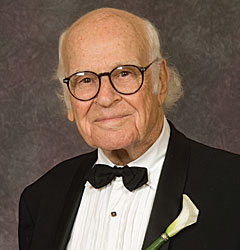
Samuel H. Moerman, JD ’34. Moerman,
now 94, practiced with the same Washington
law firm for 55 years.
|
Paving the Road to Success
Transportation attorney to donate $2 million
Samuel H. Moerman began his career with a Washington
law firm by running errands and sorting mail.
Fifty-five years later, the senior partner was
regarded as one of the nation’s premier
transportation attorneys, representing clients
in major projects like the World Trade Center,
the John F. Kennedy International Airport, and
Port Newark, the largest containership port in
the United States.
For Moerman, practicing law has been quite a
ride.
“If it came to air, rail, trucks, or seaports,
I was there,” says Moerman, sipping tea
in his Potomac, Md., home. “I had a specialty
and it served me well.”
After decades of making strides in the legal
field, Moerman, JD ’34, now wants to spread
the wealth.
Dedicated to helping GW students earn a valuable
education, Moerman, who retired as a senior partner
at LaRoe, Winn, Moerman & Donovan, has included
in his will a $2 million bequest for GW Law School.
At 94, he still feels fortunate for a degree that
led him to a “charmed career,” he
says.
“What else could I do than give [a gift]
for people to get educated,” says Moerman,
a native Washingtonian.
As the son of immigrants growing up in the Great
Depression, Moerman learned to appreciate the
value of hard work. His path to success wasn’t
easy.
Moerman’s father, a Jewish tailor, discouraged
him from going to college after high school, arguing
that the raucous university boys racing around
the streets of D.C. in their Ford Model “T’s”
were no good. Instead, he searched for a job.
A plumber hired Moerman, then a paper company,
but the economy continued to dwindle in the early
1930s and he was soon out of work.
That’s when Moerman walked into the Clark
& LaRoe law firm at 15th and K streets, taking
a job as an office boy. In between running errands
and sorting mail, he attended night classes to
earn his law degree.
Young but eager, Moerman thirsted for the education.
“I went down to the court house after three
years of law school and said, ‘Swear me
in.’ They took a look at my birth certificate
and told me to go home and come back in three
months,” says Moerman, who had to wait to
turn the permitted age to practice law. He wasn’t
yet 21.
While Moerman’s legal career was steady
in his early days, the war effort surged and he
joined the Navy in 1943 to fulfill a civic duty.
At home, he had a wife and a three-month-old daughter.
As a cryptographer during World War II, Moerman
helped encode and decode U.S. military messages
while stationed at sea and in Arzew, Algeria;
Marseilles, France; and Naples, Italy.
With all of his later business ventures and legal
successes, Moerman still says that “helping
to win the war” is his greatest accomplishment
in life.
He served for three years.
When he returned to his Washington firm, Moerman
focused on interstate commerce. Articulate and
earnest, he climbed his way to the top during
a time when the nation was making serious progress
in transportation development.
His career path hit it big when shipping magnate
Daniel Ludwig—a billionaire and innovator
in ship design—went to the firm looking
for representation. Moerman became Ludwig’s
right hand man, helping him purchase American-Hawaiian
Steamship Co. and build his business throughout
the globe. Ultimately, Ludwig became the world’s
number one independent ship owner.
Ludwig appointed Moerman as chairman and president
of American-Hawaiian shipping for several years,
and trusted Moerman with other business ventures.
On land, Ludwig asked Moerman to seek out acreage
for ports, lead coal mining projects, and purchase
land for major developments, including what would
later become the residential community of Westlake
Village, Calif.
While uncompromising in his work ethic, Moerman
says he was known as a “gentle” attorney,
a soft spoken person who never shouted or raised
his voice inside or outside the courtroom.
“It pays to be aggressive if you’re
a boxer, but if you want to be a lawyer in the
industrial and financial world, being nonconfrontational
is very helpful,” he says.
Throughout his 55 years with his law firm, Moerman
worked on several significant projects with the
New York Port Authority. Most notably, he was
the Washington attorney for The World Trade Center,
a series of buildings, including the twin towers,
which fell in the Sept. 11, 2001, terrorist attack.
For 15 years, Moerman’s office was on the
38th floor of one of the towers.
Watching the buildings collapse, “[W]as
like watching something that I loved get killed,”
says Moerman, who has a framed picture of the
towers in a sitting room at his home.
Moerman says his career, which spanned more than
a half-century, was always varied and always interesting.
He argued before the Supreme Court eight times.
He lectured other lawyers on how to make a case
in Washington to gain federal money for airports
and seaports. He was the go-to guy on transportation
issues.
While it wasn’t the life he imagined when
he was young, a courtroom—like a stage—suited
Moerman’s penchant for eloquent speaking.
Even as a teen, he enjoyed reciting poetry for
his high school class and reveled in the written
word.
Now in his 90s, Moerman still enjoys reciting
the lines of a famous oration by John Donne as
if he’s standing in the spotlight:
“No man is an island, entire of itself,”
Moerman says, his voice raising just a bit to
emphasize certain words. “Every man is a
piece of the continent, a part of the main.”
The 17th century verse about the interconnectedness
of humanity seems even more fitting now for Moerman.
His $2 million gift to the Law School is a legacy
like no other, as his generosity will help law
students achieve their own “charmed”
careers.
The contribution will touch the lives of GW’s
finest.
“Therefore do not seek to know for whom
the bell tolls,” Moerman continues. “It
tolls for thee.”
—Jaime Ciavarra

Lifelong Partnership Lives on Through Nash-Cibinic
Chair
Nash and Cibinic—for nearly half a century,
the names Ralph Nash Jr., JD ’57, and John
Cibinic Jr., JD ’60, were uttered in the
same breath by government contracts students and
practitioners alike. Widely recognized as the
patriarchs of government procurement law, the
team created the academic discipline of government
contract law at GW, educated a generation of students,
and co-wrote the field’s core texts.
When John Cibinic passed away unexpectedly in
his sleep in August 2005, he left a huge void
in the lives of his family and colleagues. To
honor and perpetuate his and Nash’s lifelong
contributions to government procurement law, GW
Law School Dean Fred Lawrence recently announced
the establishment of the Nash and Cibinic Government
Contracting Industry Chair. More than $600,000
has already been raised toward the $2 million
goal, and contributions continue to pour in—a
token of the high regard that former students
and industry professionals feel for the duo.
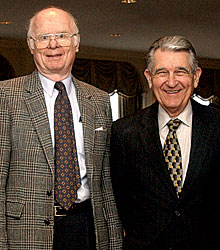
Ralph Nash and John Cibinic’s legendary
professional partnership was recognized
by GW Law School in 2002, when the duo received
the George Washington University Distinguished
Law Alumnus Award.
|

|
“Professors Nash and Cibinic really defined
the field of government procurement law and educated
most of the leading contract lawyers,” says
campaign chair and contributor J. Richard (Rick)
Knop, JD ’69, senior managing director and
co-head of defense and government services for
BB&T Capital Markets/Windsor Group. “They
are revered in government contracting law, and
I’m honored to take a leading role in endowing
the Nash-Cibinic Chair at GW Law School.”
An investment banker who focuses his career exclusively
on the government defense contracting industry,
Knop says that the chair will take the government
procurement law program to a whole new level.
“We’re already recognized as the number
one law school in the world in the area of government
procurement law, thanks in large part to the tremendous
contributions of Professors Cibinic and Nash,”
Knop says. “Through the Chair, we will move
the program forward by building upon the strength
of its outstanding full-time faculty, offering
graduate fellowships, expanding public forums
and lectures, increasing course offerings, beefing
up support for faculty research and publications,
and welcoming visiting scholars and policy officials
from abroad.”

|
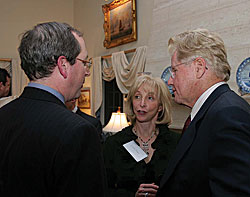
Chair campaign contributor Ed Phelps and
wife Linda with GW Law School Dean Fred
Lawrence
|
It’s a fitting tribute to Nash and Cibinic,
who brought international acclaim to GW for their
pioneering work, touching many lives in the process.
“What John and Ralph built is breathtaking,”
says Steven L. Schooner, senior associate dean
for academic affairs and co-director of GW’s
government procurement law program. “They
created an academic discipline, established a
core curriculum which, in large part, remains
intact today, wrote a foundational library to
facilitate the study of government contract law,
influenced the thinking of more than a generation
of attorneys in the field, and cemented GW Law
School at the academic center of federal procurement
law. My colleagues, Chris Yukins, Joshua Schwartz,
and Fred Lees, and I daily endeavor to fulfill
John and Ralph’s legacy.”
The program started simply enough, reflects Nash,
who learned government contracting law “from
four very good bosses” while working for
the government in the 1950s. “GW Law School
contacted me in 1960 and asked if I’d be
willing to set up a government contracts program,”
he recalls, noting that no other university had
previously identified government procurement law
as a specialized field of study. The rest is history.
Nash founded the program in 1960, the year Cibinic
graduated from GW Law, and was joined by Cibinic
in 1963.
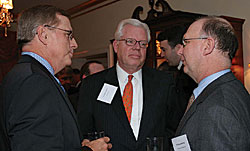
Rand Allen, Carlton Jones, and William Mutryn,
JD ’75
|

|
Over the years, the team wrote a series of books
that literally defined procurement law. In 1966,
they came out with the first edition of their
Federal Procurement Law casebook, followed by
second and third editions, as well as a series
of specialized texts. Their volumes became classics—a
staple of every government contracts office nationwide.
The duo also won acclaim for their widely read
and insightful monthly periodical, the Nash &
Cibinic Report. Both taught at GW until their
retirement in 1993 as professor emeriti and continued
to collaborate professionally until Cibinic’s
death.
Writing in a memorial published in the Public
Contract Law Journal, GW Law alumnus Jim
Nagle, LLM ’81, SJD ’86, explained:
“It is common to talk of Nash and Cibinic
as the Williston and Corbin of federal contract
law. [Yet, even that does] not sufficiently describe
their impact. When Williston and Corbin wrote
their renowned treatises on contract law, contracts
had been a defined area of study for centuries....
Not so with federal contracts. What Nash and Cibinic
did for government contract law is the jurisprudential
equivalent of the ‘perfect storm’:
the perfect combination of the right people at
the right point in time and the right geographic
location creating an awesome force.”

|
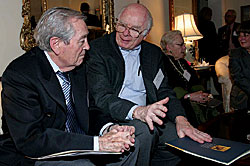
Chair campaign contributor Sy Herman, LLM
’66, and Ralph Nash at the campaign
kick-off reception at the home of Rick Knop,
JD ’75, in November
|
A special career highlight for Nash was establishing
a vibrant post-JD government contracts program
at GW. “Over the years, somewhere in the
range of 300 to 350 people received their LLM
degree in government procurement law at GW and
another 350 students took the bulk of our courses
as JD candidates,” Nash says. “Government
contracting law is a complex web of rules and
regulations, and we tried to expose our students
to every aspect of the field from beginning to
end.”
One beneficiary of the team’s work was
Edwin Phelps, JD ’68, who made a substantial
gift to the campaign. “I entered law school
in 1964, when the government procurement law program
was just starting, and was very impressed with
what John and Ralph were doing,” he says.
“At the time, I worked at the Navy Department
as a contract negotiator and took all the government
procurement courses that GW had to offer. I used
a lot of the knowledge that I gained in the program
to start my company, Educational Services Institute
[now ESI International], which has offered courses
in government contracts law for more than 25 years
now.”
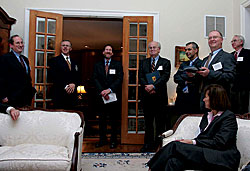
Campaign chair Rick Knop, JD ’69,
(second from left) gives an overview of
plans for the Nash-Cibinic Chair at the
kick-off reception at his home.
|

|
Phelps kept in touch with Nash and Cibinic through
the years, tapping the duo to speak at ESI courses.
In the early 1990s, GW approached ESI to run the
continuing education courses of the government
contracts program. “I enjoyed a long, productive
relationship with Nash and Cibinic while I owned
ESI,” Phelps says. “They were instrumental
in creating the field of government contracting
law and making it a real profession and legal
specialty.”
Another early student was Sy Herman, LLM ’66,
a long time supporter of GW Law who also made
a substantial gift to the campaign. Herman had
a successful career with IBM and Arthur Anderson
and helped establish key profit policies in government
contracting, among other achievements. As one
of the early graduates of the government contracting
LLM program, Herman remembers Cibinic as a master
of his trade. “He was just phenomenal in
terms of his understanding of the information,”
Herman says. “He was the first one to really
analyze cases, interpret the regulations, and
give commentary on their meaning.”

|
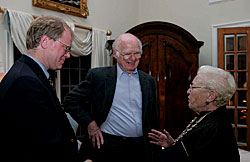
Christopher R. Yukins, co-director of the
government procurement law program, Ralph
Nash, and retired judge Ruth Burg, BS ’45,
JD ’50
|
Along with the establishment of the endowed chair
in Nash and Cibinic’s honor, GW Law is facilitating
the development of a Government Contracting Industry
Advisory Board to draw upon the advice and expertise
of leaders from throughout the field. “The
advisory board is a wonderful way for GW Law to
plug into the government contracting industry,
which is headquartered here in Washington, and
a great new avenue for industry professionals
to interact with their peers and with the Law
School,” Knop says.
The idea took flight at a campaign kick-off reception
hosted by Knop in November at his McLean, Va.,
home. “We invited all the leading government
contract lawyers in the industry to attend, and
many of them said that they’d never been
to such a large gathering of industry professionals
before,” Knop recalls. “We realized
that an advisory board would be a wonderful networking
opportunity offering attractive two-way benefits
to practitioners, as well as the Law School. It’s
a great addition to the Nash-Cibinic Chair.”
“The community’s response in building
the Nash & Cibinic Fund has been incredibly
gratifying,” says Associate Professor Christopher
R. Yukins, who co-directs the procurement law
program at the Law School. “Rick Knop reminds
us that the fund can help move our program to
the next level, and he’s right. To me, that
means being able to do more cutting-edge international
and comparative work, particularly with the United
Nations, the World Trade Organization, and other
international organizations. Looking outside of
the U.S. federal procurement system is increasingly
important to our students and to the procurement
community worldwide.”
Schooner, who will provide leadership to the
advisory board, is excited about the new venture.
“No matter how you slice it, government
procurement is big business, and many believe
it is the primary engine that drives the D.C.-area
economy,” he says. “GW Law School
is, therefore, a perfect home for the Government
Contracting Industry Advisory Board.”
Jean Cibinic, John’s widow, says that her
family is deeply moved by the establishment of
the endowed chair. “We are extremely appreciative
to the Law School for establishing the Chair to
commemorate Ralph and John’s 50-year collaboration
and dedication to the field of government contract
law, as well as their contributions to the quality
and reputation of the law school,” she states.
“We are also grateful to all of those who
made generous donations to the Chair, which will
allow their long friendship and partnership to
be recognized and carried forward.”
Nash, too, is delighted with the honor. “John
was a smart, caring guy, who inculcated thousands
of students with his knowledge and work ethic,
earning their lasting admiration and long-standing
friendship,” he says. “It was a privilege
to work closely with him for 45 years. I’m
pleased that our longstanding partnership will
live on through the faculty chair. It’s
a great way to perpetuate the program and our
work.”
—Jamie L. Freedman
For more information on the Government Procurement
Industry Advisory Board or the Nash and Cibinic
Government Contracting Industry Chair, please
contact Associate Dean Steven Schooner at 202-994-6288,
e-mail
sschooner@law.gwu.edu, or Rich Collins at
202-994-6117, e-mail rcollins@law.gwu.edu.
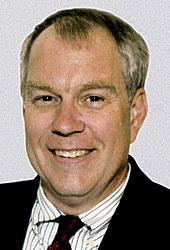 The
Dean’s Fund The
Dean’s Fund
Today, more than ever, we rely on our Dean’s
Fund members to provide scholarships, to
support the faculty and clinics, to improve
our library, and to enhance our facilities.
While we continue to seek major and planned
gifts for endowments and capital projects,
gifts to the Dean’s Fund enable us
to remain competitive and address our most
important needs.
We thank Weston D. Burnett, JD ’75,
LLM ’83, for his continuous service
as the Law School Dean’s Fund Chairperson. |

The George Washington University Law Firm Challenge
This year, The George Washington University Law
School Advancement Office has established a Law
Firm Challenge to involve alumni in the life of
the Law School and to promote alumni participation
in the GW Law Annual Fund.
How does it work?
Each participating firm has at least one volunteer
agent who encourages colleagues to make a gift
to the Law Annual Fund. Agents receive progress
updates throughout the year and every other week
from April through June, as well as helpful hints
and strategies to facilitate peer solicitation.
Why is the Law Firm Challenge
important?
The GW Law Firm Challenge helps raise funds for
the Law Annual Fund. Gifts to the Dean’s
Fund are a vital source of funding for GW Law,
providing support for faculty recruitment and
development, student financial assistance, and
the community clinics as well as enhanced library
and teaching facilities. In short, gifts to the
Law Annual Fund fuel the most vital programs,
those that allow GW Law to attract the best and
brightest law students.
Alumni Volunteers &
Participating Firms
A special thanks to our Law Firm Challenge chair,
vice chair, and partner agents who will help make
this year’s Law Firm Challenge a success!
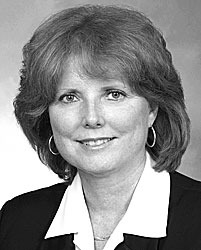
Carol Elder Bruce, JD’74
|

|
Venable LLP
Carol E. Bruce, JD ’74, Law Firm Challenge
Chair
Hogan & Hartson LLP
Jonathan S. Kahan, JD ’73, Law Firm
Challenge Vice Chair
Skadden, Arps, Slate, Meagher & Flom
LLP & Affiliates
Mike Naeve, JD ’84, Partner Agent
Morgan Lewis & Bockius LLP
James R. Sims III, JD ’86, Partner Agent
Winston & Strawn LLP
Barry J. Hart, JD ’73, Partner Agent

Dean’s Dinner in Manhattan

|
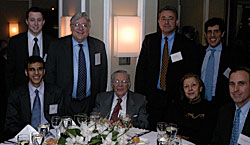
Back row, from left: Adam H. Koblenz, JD
’06, Michael R. Koblenz, JD ’74,
John J. Hay, JD ’80, Robert P. Lewis,
JD ’80. Front row, from left: Amir
Shaikh, JD ’06, Dr. Irving Ladimer,
JD ’40, SJD ’58, Doris Bendheim,
Raymond J. Dorado, JD ’83
|
Earlier this year, Dean Frederick M. Lawrence
held a Dean’s Dinner in New York City to
reengage alumni in the life of the Law School
by hosting a special dinner for 60 alumni in leadership
positions living and or working in the New York
City metro area. The dinner was hosted by New
York City Dean’s Dinner Chair, Douglas E.
Davidson, JD ’71, and was held Jan. 24 at
the ASTRA restaurant in Manhattan.
Traditionally, the Dean’s
Dinner recognition and engagement activities have
been held in the Washington, D.C., area. Dean’s
Fund Chair, Weston D. Burnett, JD ’75, LLM
’83, was pleased with this year’s
outreach efforts to alumni living in the New York
City area. This special event provides Dean’s
Fund members (individuals who have given $1,000
or more during the past year) with an opportunity
to become better acquainted with the dean, receive
Law School progress updates, network with other
professionals, and reconnect with fellow GW Law
graduates.
 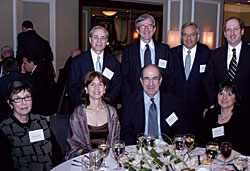 Back
row, from left: Douglas E. Davidson,
JD ’71, Lawrence Zweifach, JD
’73, Gary C. Granoff, JD ’73,
Dean Frederick M. Lawrence. Front
row, from left: Sandy Davidson, Kathleen
Lawrence, Steven A. Tasher, JD ’73,
Barbara Tasher
|
 |
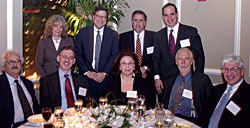
Back row, from left: Terri Hassid,
Hon. William P. Barr, JD ’77,
Erik A. Tepper, JD ’82, Roger
L. Stavis, JD ’82. Front row,
from left: Jack Hassid, JD ’70,
Alan H. Kress, JD ’71, Marilyn
Kress, Robert N. Solomon, JD ’68,
Ira L. Sorkin, JD ’68
|
|
|